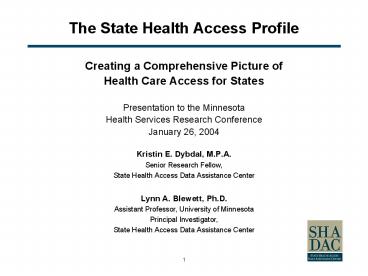The State Health Access Profile - PowerPoint PPT Presentation
1 / 17
Title:
The State Health Access Profile
Description:
Report cards, profiles, consumer reports measuring performance of hospitals, ... Examples: Consumer Assessments of Health Plans (CAHPS), PacifiCare Quality Index ... – PowerPoint PPT presentation
Number of Views:57
Avg rating:3.0/5.0
Title: The State Health Access Profile
1
The State Health Access Profile
- Creating a Comprehensive Picture of
- Health Care Access for States
- Presentation to the Minnesota
- Health Services Research Conference
- January 26, 2004
- Kristin E. Dybdal, M.P.A.
- Senior Research Fellow,
- State Health Access Data Assistance Center
- Lynn A. Blewett, Ph.D.
- Assistant Professor, University of Minnesota
- Principal Investigator,
- State Health Access Data Assistance Center
2
Rationale for Introducing State Health Access
Profile
- State Health Access Data Assistance Center
(SHADAC) - Work with states to monitor rates of health
insurance coverage - Broader focus is to understand factors associated
with health access - Health insurance coverage is just one measure of
access - For some populations, coverage is not a viable
vehicle for obtaining services - Focusing on coverage alone misses key differences
across states in - public program characteristics
- availability of safety net services
- employer markets, and
- system-wide health care resources
- Objective is to develop comprehensive profile of
access that goes beyond information on health
insurance coverage - Profile will continue to be refined
3
Background on Health Care Report Cards
- Movement to evaluate health care quality and
better inform consumers, employers, providers - Report cards, profiles, consumer reports
measuring performance of hospitals, health plans,
physicians - Examples Consumer Assessments of Health Plans
(CAHPS), PacifiCare Quality Index - Broad (and controversial) indices measuring
human development across countries - United Nations Development Programme and others
- Components include life expectancy, literacy,
school enrollment, standard of living - State-by-state efforts to track educational,
social, or economic well-being of children
and families - Example KidsCount project, AECF
4
Theoretical Framework for a State Health Access
Profile
Aday Andersons Behavioral Model of Health
Services Use
Source Anderson, Ronald M. Revisiting the
Behavioral Model and Access to Medical Care Does
It Matter? Journal of Health and Social Behavior
(1995)
5
Measures of Potential Access and Data Sources
Household Resources
6
Measures of Potential Access and Data Sources
Community Resources
7
8
Targeted Review of Twelve States
Percent of People Without Health Insurance
Coverage Three-Year Average, 2000-2002
Source US Census Bureau, Current Population
Survey, 2001-2003 Annual Social and Economic
Supplements
9
10
Hypothesis Coverage Rates Will Be Associated
with Good Economic Indicators
Health Insurance Coverage Percent of Population
TX, NM, CA, LA, OK
Income Percent of Population 100 FPG
MN, RI, WI, IA, MA, NH
AK
11
Hypothesis Coverage Rates Will Be Associated
with Strong Employer Markets
Health Insurance Coverage Percent of Population
TX, NM, CA, LA, OK, AK
IA
Employer-Sponsored Coverage Percent Offering
Coverage to Employees
MN, RI, WI, MA, NH
12
13
Hypothesis State Public Program Expansions Will
Be Associated with Lower Uncompensated Care
Spending
State Public Program Expansions Beyond Federal
Minimums
MN, WI NM, CA
OK
Uncompensated Care Spending Per Population Under
200 FPG
IA, NH TX, LA, AK
MA, RI
14
Hypothesis State Public Program Expansions Will
Be Associated with Fewer Community Clinics
State Public Program Expansions Beyond Federal
Minimums
IA TX, LA, OK
WI CA
BPHC Supported Clinics Per 100,000 Population
Under 200 FPG
MN, RI, MA NM
NH AK
15
Summary Observations (12 States)
- We find associations between good economic
indicators (e.g., income) and health insurance
coverage rates, as expected - A more comprehensive profile of health care
access helps to dispel the myth that high rates
of coverage are a function of generous public
programs - Employer-sponsored coverage rates equally if not
more important in most states - States that have expanded their Medicaid programs
to a lesser degree than others rely more heavily
on hospital uncompensated care - Same trend does not appear to hold for community
clinics
16
Implications
- Health insurance status is just one measure
helpful in tracking health care access in the
states. - A state-by-state effort to measure health care
access is both necessary and achievable with
existing data sources. - States vary in demographics employer markets
coverage rates public program coverage and
enrollment safety net and system-wide health
care resources. - Richer and more accurate comparisons are possible
using a broader array of measures. - Such an effort could ultimately incorporate other
determinants of access other population
characteristics (e.g., demographics, health care
need), health behavior, and outcomes. - Question remains Can we move from profile to a
ranking or scoring of states?
17
SHADAC Contact Information
www.shadac.org 2221 University Avenue, Suite 345
Minneapolis Minnesota 55414
(612) 624-4802
Principal Investigator Lynn Blewett, Ph.D.
(blewe001_at_umn.edu) Co-Principal Investigator
Kathleen Call, Ph.D. (callx001_at_umn.edu) Center
Director Kelli Johnson, M.B.A.
(johns706_at_umn.edu) Research Associate Michael
Davern, Ph.D. (daver004_at_umn.edu) Senior Research
Associate Timothy Beebe, Ph.D.
(beebe002_at_umn.edu) Senior Research Fellow
Kristin Dybdal, M.P.A. (dybda003_at_umn.edu)































